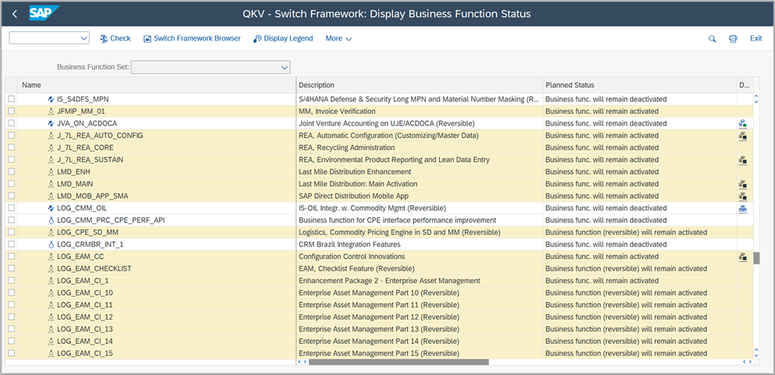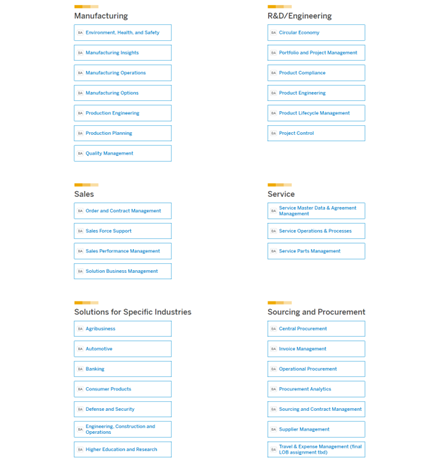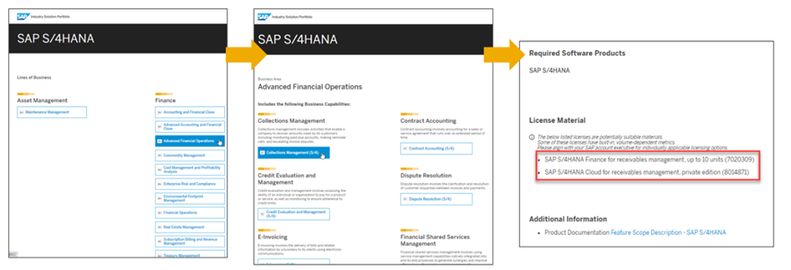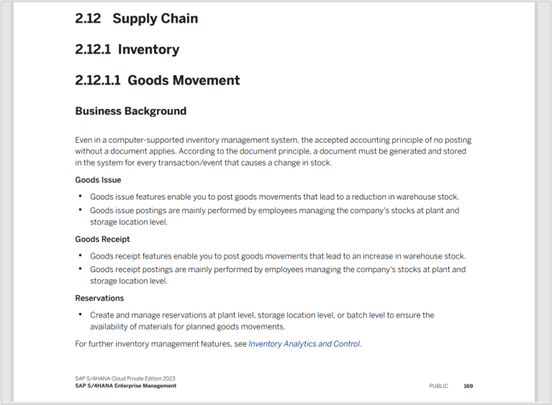
- SAP Community
- Products and Technology
- Enterprise Resource Planning
- ERP Blogs by SAP
- Business functions, capability model, Fiori apps -...
- Subscribe to RSS Feed
- Mark as New
- Mark as Read
- Bookmark
- Subscribe
- Printer Friendly Page
- Report Inappropriate Content
What are “Business Functions” in general?
Business Functions (BFs) are technical switches in an SAP ERP system. SAP provided new or additional features and enhancements in self-contained units for an existing SAP ERP installation. Business Functions need to be switched on intentionally, which sometimes is not reversable.
From a technical view, the business functions can be used to activate coding sequences, menu entries, new fields on the application interfaces and Customizing activities in the Implementation Guide. In order to activate them, the customer (partner) calls transaction SFW5 (Switch Framework).
Business Functions in SAP ERP / Business Suite
Besides the technical activation, BFs had a commercial implication in the Business Suite: it was possible to link the activation of BFs to an additional license requirement, if there was one. These licensing requirements are documented in SAP note 1524246 - Relationship of licenses and business functions
Business Functions in SAP S/4HANA
With the transition to SAP S/4HANA, many BFs were set to “always on” or always off” for simplification: some classic functionalities no longer exist in SAP S/4HANA because they were duplicates (actually up to fourfold) of functionalities. Others became standard functionality - in some cases, extra licensing requirements in the Business Suite were waived and the functionality defined as core-licensed in S/4HANA.
These settings are documented in the notes
- 2240359 - SAP S/4HANA: Always-Off Business Functions
- 2240360 - SAP S/4HANA: Always-On Business Functions.
Therefore, some BFs still exist in SAP S/4HANA, but generally speaking, they are no longer consistently used, only in exceptional cases.
Implications
With this change, BFs can no longer be used as a commercial element / license indicator in SAP S/4HANA. Consequently, there never will be a note for SAP S/4HANA which is comparable to 1524246.
SAP’s License Auditing for example does not evaluate BFs on SAP S/4HANA systems. All extra-licensed solutions have measurement procedures looking at indicators of productive usage, like transactions/Fioris called, data in specific tables, etc.
In other words: BFs may still be necessary to technically activate functionality - extra-licensed or core-licensed. But they are no longer used as a licensing indicator in SAP S/4HANA.
The underlying commercial model in SAP S/4HANA was completely redefined, on the basis of the capability model, which will now be explained.
The capability model - basic structure for licensing in SAP S/4HANA
The basic commercial structure of SAP S/4HANA is a functional model, the business capability model (BCM). It consists of three layers: (1) Lines of Business, (2) Business Areas, (3) Solution Capabilities. The solution capabilities carry the licensing information, descriptions, and more.
The complete capability model can be viewed on SAP’s Industry Solution Portfolio pages, one for SAP S/4HANA’s private cloud edition (and on-premise), and one for the public cloud edition.
On the solution capability level, licensing prerequisites are displayed (“License Material”).
Core functionalities ("Enterprise Management") are covered by
- the respective RISE licenses (metric of Full Usage Equivalents (FUEs) in private and public cloud)
- one of the three use type-related licenses (Professional, Functional, Productivity) for on-premise.
For premium functionalities, the respective Industry or LoB license materials are displayed:
"I need more details": the Feature Scope Description (FSD)
The FSD is the legally binding scope description of SAP S/4HANA, for all deployments. It automatically becomes part of all SAP S/4HANA contracts via a reference in SAP’s General Terms and Conditions.
You should easily find the name of a solution capability in the FSD because the capability model is the guideline for the FSD's structure - at least in the Enterprise Management area. In other words: the core solution capabilities appear there as headlines, under which you'll find more details about its business background, key features, and (sometimes) technical information.
The FSD also shows a licensing indication:
- all capabilities / features described in the “Enterprise Management” chapter are covered by the respective core license (FUEs in SAP S/4HANA Cloud public and private)
- features described in the chapters “Enhanced LoB Functions” and “Industry Specific LoB Functions” require a separate license.
Solution capabilities in legal documents
The Software Use Rights (SUR, for SAP S/4HANA on-premise), and the Service Description Guides (SDG, for all SAP S/4HANA Cloud flavors) explicitly list the use types and their associated solution capabilities. Since these documents are part of all S/4HANA contracts, the consistency between the capability model (visualized via the Solutionportfolio page), the FSD and the SUR and SDG is absolutely vital.
The SDGs and SURs are available on SAP’s Trust Center page.
Other usages of the capability model / the solution capabilities
Solution capabilities are associated to innovations, which are maintained by SAP’s Product Management. This enables customers to filter content in the Roadmap Explorer tool.
There are at least 10 other cases of tools and assets where the Business Capability Model is used to structure information for external and internal consumption: Digital Discovery Assessment*, usage measurement*, Fiori Apps Library, Innovation Feature Repository*, modelling in Signavio, the What’s New viewer, slide decks like the L2L3 Business Scope deck*, S/4HANA Capability Description*, etc.
(* SAP internal/partners only, some available on request – please contact your Account Executive)
When does a Fiori app require an additional license?
Fiori apps are associated with ideally one, sometimes multiple solution capabilities, visualized in the Fiori Apps Library. In case of doubt, you can assume that the respective premium license is required if it is referenced here via a solution capability.
Closing off with a recommendation: get the latest status about the RISE with SAP S/4HANA Cloud Pricing and Packaging from my colleagues Arne Neumann and @Bruno_Angstmann here: https://www.youtube.com/watch?v=Dt5SzlHEoNY
- SAP Managed Tags:
- SAP S/4HANA,
- SAP S/4HANA Private Cloud,
- SAP S/4HANA Public Cloud
You must be a registered user to add a comment. If you've already registered, sign in. Otherwise, register and sign in.
-
Artificial Intelligence (AI)
1 -
Business Trends
363 -
Business Trends
24 -
Customer COE Basics and Fundamentals
1 -
Digital Transformation with Cloud ERP (DT)
1 -
Event Information
461 -
Event Information
24 -
Expert Insights
114 -
Expert Insights
160 -
General
1 -
Governance and Organization
1 -
Introduction
1 -
Life at SAP
415 -
Life at SAP
2 -
Product Updates
4,684 -
Product Updates
220 -
Roadmap and Strategy
1 -
Technology Updates
1,502 -
Technology Updates
89
- Enterprise Portfolio and Project Management in SAP S/4HANA Cloud, Private Edition 2023 FPS1 in Enterprise Resource Planning Blogs by SAP
- SAP S/4HANA Cloud, Private Edition for Service | 2023 FPS1 Product Update in Enterprise Resource Planning Blogs by SAP
- SAP Fiori for SAP S/4HANA – Upgrade Faster – Managing app lifecycle impacts on users in Enterprise Resource Planning Blogs by SAP
- SAP S/4HANA Cloud Private Edition | 2023 FPS01 Release – Part 2 in Enterprise Resource Planning Blogs by SAP
| User | Count |
|---|---|
| 11 | |
| 10 | |
| 9 | |
| 8 | |
| 7 | |
| 7 | |
| 6 | |
| 5 | |
| 4 | |
| 4 |









